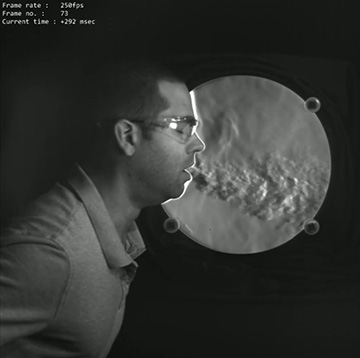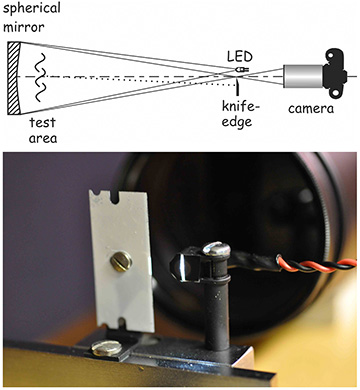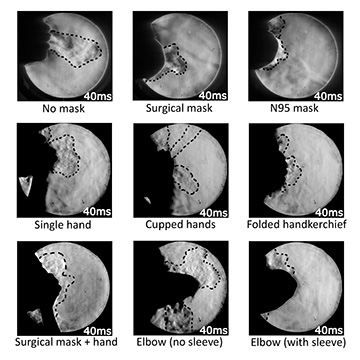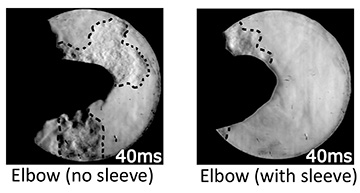
In a public-outreach effort earlier this year, NIST scientist Matthew Staymates used schlieren photography to qualitatively, and graphically, show the difference in how far a plume of breath can spread with and without a face covering. [Image: still NIST video]
The COVID-19 pandemic has mobilized and focused the scientific community as never before, with researchers hard at work toward vaccines and treatments, and seeking other ways to press technology into service in slowing the spread of the disease. Not all of the techniques capable of making a contribution, however, are necessarily new or “cutting edge.” One example is schlieren photography, an optical approach to visualizing airflows that was first developed more than a century and a half ago.
In the months since the pandemic gripped the world, one U.S. researcher has used this venerable optical technique, in a home-built lab, to create compelling videos underscoring the importance of wearing face coverings. And, in research published today, a pair of scientists in India have employed schlieren imaging to shed further light on what happens to human cough airflows over long distances in the presence or absence of masks—and on fluid-dynamic details that could help in understanding the physics of disease transmission (Phys. Fluids, doi: 10.1063/5.0021666).
Lamp, mirror, razor blade, camera
Originally invented in 1864, schlieren photography is a workhorse in aeronautical engineering—where it is used to image airflows in wind tunnels, for example—as well as in a variety of other niche areas such as detection of drugs and explosives. The technique works by detecting variations in the refractive index in a moving fluid due to temperature and density gradients.
In a typical schlieren setup, a lamp approximating a point source, such as an LED, is shone into a spherical concave mirror with a long focal length. The test subject is positioned in front of the mirror, and light bouncing off of the mirror and passing through the test area is returned to a camera positioned somewhat behind the mirror’s focal point. At the focal point itself, a thin barrier—typically a knife edge or razor blade—is carefully placed so that it blocks out a portion, but not all, of the light leading back to the camera.
Top: Simplified diagram of a schlieren photography setup. Bottom: In many setups, a razor blade is used in the role of the knife edge, to block out part of the returning light at the mirror focal point. [Images: J.W. Tang et al., PLOS One, doi: 10.1371/journal.pone.0021392 (2011); CC BY 4.0] [Enlarge image]
When a fluid, such as warm, moisture-containing breath, passes through the test area, the changes in temperature and density caused by the moving fluid locally shift the refractive index, bending the light so that it is blocked by the knife edge. The light that finds its way to the camera thus shows a pattern of light and dark patches, due to this selective refraction, that delineate the airflow. And when those images are captured with a high-speed camera and stitched together into video, they can provide compelling qualitative visualizations of just what happens when we exhale or cough.
Visualizing the invisible
The use of schlieren photography to image exhaled human airflows isn’t a brand-new idea. In the late 2000s and early 2010s, for example, researchers led by Gary Settles of Penn State University and Julian Tang of the National University Hospital, Singapore, used the technique in a variety of academic studies that offered insights on the dynamics of human coughs, sneezes and breathing.
With the onset of COVID-19, however, the technique’s strengths in visualizing the otherwise invisible have taken on new relevance—both in the scholarly quest to understand the mechanisms of virus transmission, and in the effort to persuade the public of the importance of measures such as social distancing and face coverings to stem the disease’s spread.
One scientist who has been active in using schlieren imaging on the public-outreach side is Matthew Staymates, an experimental fluid dynamicist at the U.S. National Institute of Standards and Technology (NIST). Staymates, who trained under Gary Settles at Penn State, typically has used schlieren photography as a technique for detecting drugs and explosives. “It turns out,” he told OPN, “that schlieren is a really powerful tool to try to understand how to sample for these kinds of things in the environment.”
The value of striking images
As the pandemic spread—and, in particular, as public controversy grew about the role and importance of wearing face coverings to stem the spread of the virus—Staymates realized that schlieren photography could offer a way to raise public awareness of the importance of face coverings. “It’s a very visual technique, and the visuals are quite striking,” he says. “They’re very powerful, and they’re fairly easy for the average person to understand.”
Separated from his lab by coronavirus stay-at-home orders, however, Staymates had to improvise. He obtained permission from NIST to bring some of his lab gear home—which was “a real gift,” he says. “I’m kind of a lab nerd, and the idea of being stuck at home ‘teleworking,’ as a professional scientist, was really starting to stress me out.”
In addition to being a lab nerd, Staymates is also an avid woodworker—and, drawing on these talents, he converted his basement shop into a schlieren imaging lab, which he used to visualize airflows when he exhaled or coughed, both without a mask and with different kinds of face coverings. (He documented his efforts in a popular blog post on the NIST site.)
Viral video
NIST’s Matthew Staymates used schlieren photography to create a video showing airflow patterns from exhaled breath and coughing, in an effort to raise public awareness of the role of masks in preventing the pandemic’s spread. [Credit: NIST]
The result of these efforts was a viral online video that graphically showed the difference made by wearing face coverings—and that spurred a huge reaction. “A lot of people wrote to me personally,” Staymates reports, “and said, ‘Hey, thank you so much—my family was so against masks, and I showed them this and now they understand.’” He says he’s also heard from other federal organizations with offers to collaborate, and even from science museums, which want to post the videos at their building entrances, to underscore to patrons the importance of keeping their faces covered during their visits.
The experience also has Staymates exploring new research possibilities for his schlieren setup. “We’ve found kind of a new application space for schlieren that we weren't really tapped into before,” he says. “There are a lot of really cool things happening.”
Staymates does offer one caveat, however. “Schlieren is good at helping us understand airflows,” he warns, “but we can’t make any claims about droplet mitigation using schlieren … We’re looking at airflows and refractive-index changes; we’re not looking at droplets and virus transport.” He stresses that it’s “critical to do that messaging, or the untrained eye could draw the wrong conclusions.”
The fluid dynamics of coughing
A research team in India uses schlieren imaging to compare outflow patterns with varying degrees of face covering—and to uncover quantitative insights on the fluid dynamics of human coughs and breathing. [Image: Padmanabha Prasanna Simha, Indian Space Research Organisation] [Enlarge image]
Meanwhile, other research groups are also leveraging schlieren imaging in an effort to better understand how to manage human airflows and contagion in the COVID-19 era. In a paper published today in Physics of Fluids, two Indian researchers—Padmanabha Prasanna Simha, an aeronautical engineer at the Indian Space Research Center, and Prasanna Simha Mohan Rao, a physician with the Sri Jayadeva Institute of Cardiovascular Sciences and Research—shed further light on the efficacy of face coverings, and on the detailed fluid dynamics of human coughing.
The research team came together naturally in this case; Mohan Rao and Prasanna Simha are father and son. “There’s been so much controversy on masks—people saying you should wear them, you shouldn’t wear them, they work, they don’t work” says Mohan Rao. “And I said to my son, Why don’t we study this?”
Drawing on his experience in the aeronautical lab, Prasanna Simha set up a schlieren system to do just that, using a 300-mm-diameter, 3-m-focal length mirror taken from “a small wind tunnel,” a 250-W tungsten halogen lamp with a condenser lens to approximate a point source, and a razor blade for the knife edge. They captured images from the setup using a high-speed Phantom v641 camera, running at speeds ranging from 100 to 5000 frames per second.
The problematic bent elbow
With this setup, the pair set to work on imaging a variety of coughing scenarios. One objective was to obtain a more quantitative understanding of how the airflows from human exhalation or coughing behave over long distances. “Most previous research using schlieren imaging on human exhaled airflows has been qualitative,” notes Prasanna Simha. And they’ve been “typically close to the mouth and nose, so you don’t really get an estimate of how far the exhaled airflow is going.”
In addition to studying airflows over long distances, the team also looked at a variety of common face-covering scenarios, to gauge their effectiveness. These included, in addition to coverings such as N95 protective masks and medical masks, other common-sense approaches such as covering one’s mouth with one’s hands, or coughng into a bent elbow.
The researchers found that one common, informal way advised to limit a cough’s spread—coughing into a bent elbow—actually tends to channel the cough in the direction of the elbow, and toward others, unless the arm is covered. [Image: Padmanabha Prasanna Simha, Indian Space Research Organisation] [Enlarge image]
The latter approach—often recommended to prevent disease spread—turned out to be particularly problematic. The schlieren images suggested that, if the arm is not covered by a shirtsleeve, “the flow tends to bend along the elbow, separates at the tip of the elbow, and goes along in that direction,” says Prasanna Simha. “If you were angry with someone,” laughs Mohan Rao, “you could direct your cough at them this way.”
The importance of distance
In general, Prasanna Simha and Mohan Rao believe that their work underscores the value of masks in potentially stemming the spread of COVID-19. And their quantitative use of the schlieren technique underscores a potentially unappreciated point, they say: The efficacy of masks stems not only from their ability to filter droplets, but from their effects on reducing airflow velocity—and thus distance of spread.
“It’s not just about the filtration efficiency,” says Prasanna Simha. “If you can reduce the distance of propagation, then even if you don’t have the best filtration efficiency, the mask is still effective in terms of reducing the spread of infection.” One way the team was able to establish this, according to the researchers, was by looking at cough dispersion over longer distances.
“The problem is, with conventional schlieren setups, our field of view is restricted to the size of the mirror,” Prasanna Simha notes. “So the simple solution is to move [the test subject] out of the field of view and wait for the cough to move into the field of view. Which is a very obvious, simple solution, but it hadn’t been tried before to quantify the spreading distance of coughs.”
Vortex flows
The work by Prasanna Simha and Mohan Rao also casts some light on the detailed fluid dynamics of a typical human cough—findings that, they believe, could have their own role in better understanding how to stem human-to-human transport of the disease. Through visual analysis of the schlieren images, and by fitting the velocity–distance relationships gleaned from the images to a known analytical relation for viscous flow, the team was able to establish that the airflows from the coughs follow the physics of so-called viscous vortex rings, whether a surgical mask is worn or not.
This could be important for future research, Prasanna Simha says. “Computational studies have shown that vortex rings are able to enhance the transport of particles,” he explains. “The rotational motion of the vortex is able to offset some of [the downward tendency due to gravity] and enhance particle transport … So if you had a mask that can attenuate the strength of the vortex ring right at the beginning, it will play a huge role in minimizing the effect of distant transport.”
The results underscore, the authors conclude, that future tests using typical tools such as mannequins and cough simulators will need to “recreate similar [vortex] flow fields in order to accurately capture the propagation of airflow from coughs.”



